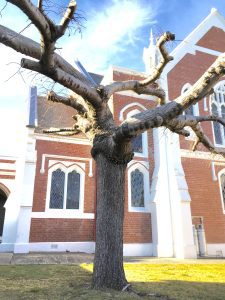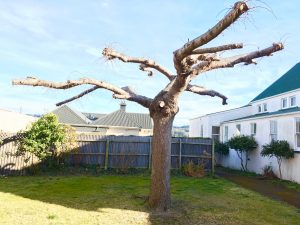When they say that a ‘leopard can’t change its spots’ they are not talking about the evolutionary process that lead to spots or the genetic make-up and pigmentation that created the spots that we see; they are just saying ‘it is what it is’. Trees are what they are too. Yes, you can twist and bend them, you can clip and shave them, you could even shape them into something that looks like a leopard – if you wanted to, but if you leave them alone for long enough they will eventually return to what they are, to what they always were going to be (assuming they don’t die first).
This un-holy crime (excuse the pun – the tree stands in the grounds of a church) was a Horizontal Elm  (Ulmus glabra ‘horizontalis’). It was a specimen tree in every way shape and form, before someone cut it. Because it is or was what it was, it was growing horizontally. If you look, you will see a graft union at the top of the trunk (a swelling / a change in diameter), this is where a horizontally growing form was stuck onto a vertically growing stem. The buds were removed from the vertical stem, leaving the only the horizontal from to sprout. Grafting like this is a fantastic way to control height – that tree has been there or about the same height for the past 80 something years.
(Ulmus glabra ‘horizontalis’). It was a specimen tree in every way shape and form, before someone cut it. Because it is or was what it was, it was growing horizontally. If you look, you will see a graft union at the top of the trunk (a swelling / a change in diameter), this is where a horizontally growing form was stuck onto a vertically growing stem. The buds were removed from the vertical stem, leaving the only the horizontal from to sprout. Grafting like this is a fantastic way to control height – that tree has been there or about the same height for the past 80 something years.
Pre-cutting the tree could have been an insurable asset worth around $75,000 (it really was that good), but now it’s not even worth the firewood. Maybe this particular church has money to burn – maybe (and I suspect this is the case), some well-meaning parishioner cut it. Maybe this well-meaning parishioner cut it to stop it growing outwards or maybe they cut it because it had too many leaves. Maybe this well-meaning parishioner felt good about taking $75,000 to the tip or maybe they burnt the brush and toasted marshmallows around their $75,000 fire…

Well-meaning or not, the tree was a specimen example of considerable value, it was healthy and structurally sound. Now it is worthless, unhealthy and structurally compromised. The regrowth will be horizontal and it will be vigorous – as a result of this cutting there will be more leaves than before, there will be more tree than before but unlike before it will no-longer be a safe tree. The regrowth will not be bound to the stem – rot will set in and there is real potential for stem failure causing someone to be harmed.
As a result of the cutting, the church has lost an asset worth $75K, it will have more mess to clean, more shading to deal with and it now has a hazard as well.
Good pruning done by a qualified arborist, would have increased the value of the church’s asset, the leaf volume could have been reduced, light levels increased and potential hazards minimised. Good pruning done by a qualified arborist would have saved money and prevented this un-holy crime.
A crime possibly worthy of divine punishment.
I too once shared your opinion on this sort of un-holy crime. I would take similar photos and make the same comments. On the contrary I used to carry out arboriculture 101 on trees and admire the work of others maintaining trees how our training and the books tell us they should be maintained.
After many many years I began to notice a funny thing. The trees which had had some un-holy act performed on them (often multiple times) still endured in the landscape whilst those trees loving tended by professionals shed limbs, were considered to be past their best, thought to be no longer serviceable, at the end of their life, dangerous, a risk or no longer aesthetically pleasing – and so inevitably would be removed and replaced some root-bound nursery tree offered as a replacement.
It has made me rethink how i manage old trees. Bits fall off trees as a part of their natural processes. If we bring trees into our lives, or simply want to control what a tree wants to to itself naturally, then we have to do this for them because it is not acceptable to allow them to do it when it suits them. When trees prune themselves the results can often be worst than an un-holy act we might perform.
So now, sometimes I might even perform such an act on a tree if it means an old tree is retained to fight another battle. Of course I prefer to find some place in the middle to reduce the crowns of trees but now, when ever i walk toward an old tree I find myself saying “how can I reduce thee, let me count the ways”.
Maybe what we see in the picture above is not actually an un-holy act. Perhaps what we are seeing it is actually an Act of God?
thanks for your thoughts – but alas, in this instance its not management or a desire to mimic a ‘natural processes’ its ignorance through and through, and ignorance is no excuse under the law; no matter which law(s) you live under. While it is conceivable that this tree could be saved, and managed back to some acceptable form or size the owners would first need to see the light and I fear that they are looking elsewhere…